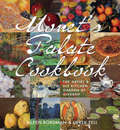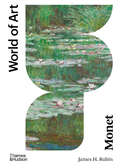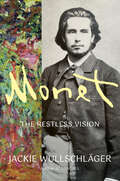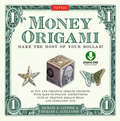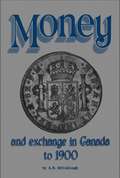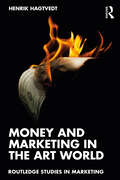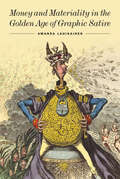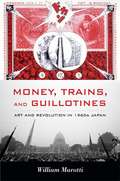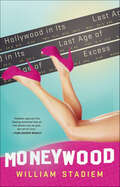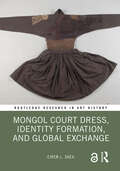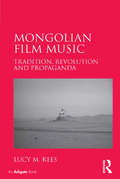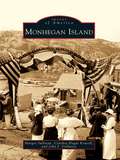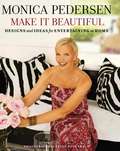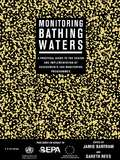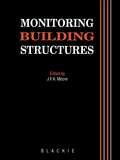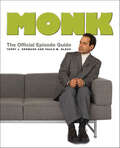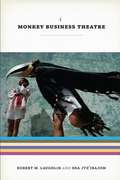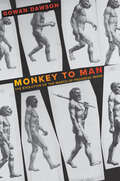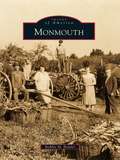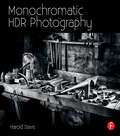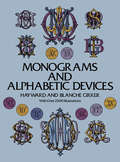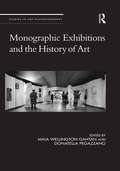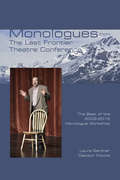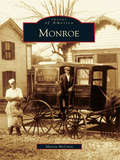- Table View
- List View
Monet's Palate Cookbook: The Artist & His Kitchen at Giverny
by Derek Fell Aileen BordmanTake a culinary journey in Monet&’s footsteps with this book featuring recipes and photographs from his bucolic Normandy home—forward by Meryl Streep. Monet's Palate Cookbook brings to life Claude Monet's beloved kitchen garden at his exquisite home in Giverny, France. With sixty recipes drawn from Giverny&’s farm-to-table tradition and the artist&’s own cooking journals, the book explores Monet&’s passion for gardening and includes detailed information about the herbs and vegetables he grew. On his two-acre vegetable garden, Monet grew zucchini, cherry tomatoes, radishes, pearl onions, brussels sprouts, asparagus, rosemary and mint. A few of the recipes are of French origin, such as the famous Normandy apple tart. Others are from locations abroad where he traveled, such as the Savoy Hotel in London where Monet acquired their recipe for Yorkshire pudding. Capturing Monet's lifestyle, Monet&’s Palate Cookbook includes beautiful photographs by Steven Rothfeld, descriptions of the house interiors and gardens, French entertaining tips, and more.
Monet: An Artist's Obsession (World of Art #0)
by James H. RubinFrom a world authority on impressionism and nineteenth-century French art comes this new addition to the World of Art series on the art and life of Claude Monet. One of the most famous and admired painters of all time, Claude Monet (1840– 1926) was the architect of impressionism—a revolution that gave birth to modern art. His technique of painting outside at the seashore or in city streets was as radically new as his subject matter: the landscapes and middle-class pastimes of a newly industrialized Paris. Working with unprecedented immediacy and authenticity, Monet claimed that his work was both natural and true, and therefore, entirely novel. In Monet, James H. Rubin, one of the world’s foremost specialists in nineteenth-century French art, traces Monet’s development, from his early work as a caricaturist to the late paintings of water lilies and his garden at Giverny. Rubin explores the cultural currents that helped shape Monet’s work, including the utopian thought that gave rise to his politics, his interest in Japanese prints and gardening, and his relationship with earlier French landscape painters and contemporaries such as E´douard Manet and Pierre-Auguste Renoir. Featuring more than 150 color illustrations of his key works, Rubin establishes Monet as the inspiration for generations of avant-garde artists and a true patriarch of modern art.
Monet: The Restless Vision
by Jackie WullschlägerA groundbreaking look at the life and art of one of the most influential, modern painters of the late nineteenth century and founder of the Impressionist movement &“Wullschläger emerges with a strikingly different picture of the artist. Passionate, prickly, edgy and unstable, her Monet, the unrecognizable Monet, is a powerful new character in art.&” —The Sunday Times (London)Drawing on thousands of never-before-translated letters and unpublished sources, this biography reveals dramatic new information about the life and work of one of the late nineteenth century&’s most important painters. Despite being mocked at the beginning of his career, and living hand to mouth, Monet risked all to pursue his vision, and his early work along the banks of the Seine in the 1860s and &’70s would come to be revered as Impressionism. In the following decades, he emerged as its celebrated leader in one of the most exciting cultural moments in Paris, before withdrawing to his house and garden to paint the late Water Lilies, which were ignored during his lifetime and would later have a major influence on all twentieth-century painters both figurative and abstract.This is the first time we see the turbulent life of this volatile and voracious man, who was as obsessed by his love affairs as he was by nature. He changed his art decisively three times when the woman at the center of his life changed; Wullschläger brings these unknown, passionate, and passionately committed women to the foreground. Monet's closest friend was Prime Minister Georges Clemenceau; strong intellectual currents connected him to writers from Zola to Proust, as well as to his friends Manet, Renoir, and Pissarro. Brilliant and absorbing, this biography will forever change our understanding of Monet's life and work.
Money Origami
by Richard L. Alexander Michael G. Lafosse$$$ Dollar, dollar bill-create fun and intricate origami using your Washingtons, Franklins, and Lincolns $$$World renowned origami artist Michael LaFosse introduces Money Origami ebook. <P><P>This origami ebook includes a whimsical collection of new origami paper craft projects designed for paper folders of any level of skill to practice the increasingly popular art of folding origami dollars. Don't bother with all the free, unreliable and confusing instructions out there to learn origami-having real, professional origami instructions right in front of you makes all the difference and saves you time. The origami practice dollar bills mean that you won't have to fold on real money and can save it up to buy some more origami ebooks!This easy origami contains: A full-colored 64 page booklet 21 money-based projects Clear step-by-step instruction and diagrams A downloadable DVD containing easy-to-follow video tutorial for each projectMoney origami is more popular than ever, thanks to the panoply of designs and the wonderful folding qualities of the dollar bill. Many people like to give cash gifts or tips in folded money. While the classic origami folds still fascinate, money-fold enthusiasts are always looking for fresh ideas. Mini Money Origami is full of original designs to learn origami quickly and easily. At such a great value-folding money has never been so easy or affordable!Origami projects include: George Napkin Ring Business Card Holder Thistle Wheel of Fortune And many more...
Money and Exchange in Canada to 1900
by A. B. McCulloughOf special interest to coin and bill collectors, as well as history buffs and students, is this clear, concise and intriguing explanation of the various coins and currencies used in Canada between 1600 and 1900. Covering the French, British, and Canadian periods of our history, the wide range of currencies used is explained: livres, pounds, playing cards, louis d’ors, eagles, shillings and dollars among others. Divided into geographical sections, each area of Canada, from Newfoundland to the West, the ever-changing conditions of money and exchange is covered in detail. The concluding chapter brings together each of these threads and weaves a unified picture of the early Canadian monetary system. Aided by a generous selection of illustrations, figures and tables, A.B. McCullough has written a comprehensive guide to our monetary history that is both useful and interesting.
Money and Marketing in the Art World (Routledge Studies in Marketing)
by Henrik HagtvedtHow does the art market choose its winners, thereby also deciding what millions of visitors to galleries and museums will view, year after year? Whereas art historical writing and contemporary commentary tend to highlight the efforts of specific artists, this book illustrates how money and marketing, in combination with general trends, play decisive roles in shaping the art world and in propelling specific artists and artworks to positions of prominence.Today, perhaps more than ever before, the high-profile art world is primarily shaped by buyers and those who cater to buyers. The actual artists, although most visible to the public, tend to play a secondary role. The time seems particularly ripe for transparency about how the art world works, given the growth in the art market, media attention on—and popular interest in—high-priced art, and controversy surrounding public funding for art and the value of art for contemporary society. With a combination of marketplace observations, marketing insights, and relevant research findings, this book contributes to increased transparency while providing thought-provoking digressions and anecdotes along the way.Money and Marketing in the Art World offers an accessible analysis of the art market for scholars and graduate students across arts marketing and management, as well as for those more broadly interested in art and business.
Money and Materiality in the Golden Age of Graphic Satire (Studies in Seventeenth- and Eighteenth-Century Art and Culture)
by Amanda LahikainenThis book examines the entwined and simultaneous rise of graphic satire and cultures of paper money in late eighteenth- and early nineteenth-century Britain. Asking how Britons learned to value both graphic art and money, the book makes surprising connections between two types of engraved images that grew in popularity and influence during this time. Graphic satire grew in visual risk-taking, while paper money became a more standard carrier of financial value, courting controversy as a medium, moral problem, and factor in inflation. Through analysis of satirical prints, as well as case studies of monetary satires beyond London, this book demonstrates several key ways that cultures attach value to printed paper, accepting it as social reality and institutional fact. Thus, satirical banknotes were objects that broke down the distinction between paper money and graphic satire altogether.
Money and Power in Anglo-Saxon England
by Rory NaismithThis groundbreaking study of coinage in early medieval England is the first to take account of the very significant additions to the corpus of southern English coins discovered in recent years and to situate this evidence within the wider historical context of Anglo-Saxon England and its continental neighbours. Its nine chapters integrate historical and numismatic research to explore who made early medieval coinage, who used it and why. The currency emerges as a significant resource accessible across society and, through analysis of its production, circulation and use, the author shows that control over coinage could be a major asset. This control was guided as much by ideology as by economics and embraced several levels of power, from kings down to individual craftsmen. Thematic in approach, this innovative book offers an engaging, wide-ranging account of Anglo-Saxon coinage as a unique and revealing gauge for the interaction of society, economy and government.
Money, Trains, and Guillotines: Art and Revolution in 1960s Japan
by William MarottiDuring the 1960s a group of young artists in Japan challenged official forms of politics and daily life through interventionist art practices. William Marotti situates this phenomenon in the historical and political contexts of Japan after the Second World War and the international activism of the 1960s. The Japanese government renewed its Cold War partnership with the United States in 1960, defeating protests against a new security treaty through parliamentary action and the use of riot police. Afterward, the government promoted a depoliticized everyday world of high growth and consumption, creating a sanitized national image to present in the Tokyo Olympics of 1964. Artists were first to challenge this new political mythology. Marotti examines their political art, and the state's aggressive response to it. He reveals the challenge mounted in projects such as Akasegawa Genpei's 1,000-yen prints, a group performance on the busy Yamanote train line, and a plan for a giant guillotine in the Imperial Plaza. Focusing on the annual Yomiuri Indépendant exhibition, he demonstrates how artists came together in a playful but powerful critical art, triggering judicial and police response. Money, Trains, and Guillotines expands our understanding of the role of art in the international 1960s, and of the dynamics of art and policing in Japan.
Moneywood: Hollywood in Its Last Age of Excess
by William StadiemAs wild and sexy and over the top as the decade it brings to life, author, William Stadiem, tells the inside story of Hollywood producers in the 80s.From hits like Beverly Hills Cop, Top Gun and Batman to flops like Heaven's Gate, Howard the Duck and Leonard Part 6, Hollywood was never more excessive than it was in the 1980s. In this, the Moneywood era, the purse strings were not controlled by reasonably consenting adults but by pop culture cowboys who couldn't balance their own checkbooks. What they could do was sweet talk the talent, seduce the starlets, snowball the Japanese and slither out of Dodge when the low grosses trickled in. Their out of control lifestyles and know-nothing, raging narcissistic personalities make the original brutal studio heads like Sam Goldwyn and Jack Warner seem like Oxford dons. Yet, for all their flops, these Scoundrels of Spago turned Hollywood into a Big Business that was catnip to Wall Street. They were The Producers, and they were way beyond anything Mel Brooks could dream up.The Moneywood cast of characters includes: -Simpson and Bruckheimer; Guber and Peters; Eisner/Katzenberg/Ovitz: An unusual fresh take on the usual subjects. -Ray Stark, the wizard of Holmby Hills, the most powerful producer of the 80s. -Mario Kassar and Andy Vajna, the Rambo boys, who went from making wigs to making blockbusters.-Menahem Golan-Yoram Globus, the Israeli schlockmeisters who proved that every star had a price.-David Begelman, the embezzler, gambler and sex addict who was rewarded for his sins by getting to run both Columbia and MGM.-Roland Betts, the aristocratic Silver Screen Partners founder and former Yale frat-mate of George W. Bush who was a master at playing the Reagan White House card.-Giancarlo Parretti, the Italian cannery worker who bought MGM, with a little help from his (Sicilian) friends.-David Puttnam The high-toned English advertising whiz who was supposed to raise the Hollywood bar, but ended up barred from Hollywood.Moneywood is the ultimate expose of the real hit men of Hollywood's go-go decade.
Mongol Court Dress, Identity Formation, and Global Exchange (Routledge Research in Art History)
by Eiren L. SheaThe Mongol period (1206-1368) marked a major turning point of exchange – culturally, politically, and artistically – across Eurasia. The wide-ranging international exchange that occurred during the Mongol period is most apparent visually through the inclusion of Mongol motifs in textile, paintings, ceramics, and metalwork, among other media. Eiren Shea investigates how a group of newly-confederated tribes from the steppe conquered the most sophisticated societies in existence in less than a century, creating a courtly idiom that permanently changed the aesthetics of China and whose echoes were felt across Central Asia, the Middle East, and even Europe. This book will be of interest to scholars in art history, fashion design, and Asian studies.
Mongolian Film Music: Tradition, Revolution and Propaganda
by Lucy M. ReesIn 1936 the Mongolian socialist government decreed the establishment of a film industry with the principal aim of disseminating propaganda to the largely nomadic population. The government sent promising young rural Mongolian musicians to Soviet conservatoires to be trained formally as composers. On their return they utilised their traditional Mongolian musical backgrounds and the musical skills learned during their studies to compose scores to the 167 propaganda films produced by the state film studio between 1938 and 1990. Lucy M. Rees provides an overview of the rich mosaic of music genres that appeared in these film soundtracks, including symphonic music influenced by Western art music, modified forms of Mongolian traditional music, and a new genre known as ’professional music’ that combined both symphonic and Mongolian traditional characteristics. Case studies of key composers and film scores are presented, demonstrating the influence of cultural policy on film music and showing how film scores complemented the ideological message of the films. There are discussions of films that celebrate the 1921 Revolution that led to Mongolia becoming a socialist nation, those that foreshadowed the 1990 Democratic Revolution that drew the socialist era to a close, and the diverse range of films and scores produced after 1990 in the aftermath of the socialist regime.
Monhegan Island (Images of America)
by John J. Galluzzo Margot Sullivan Cynthia Hagar KrusellThe natural beauty of Monhegan Island has continuously attracted generations of artists, day-trippers, and summer sojourners. White Head, Pulpit Rock, and Cathedral Woods are names that resonate throughout New England and beyond. Long before the first ferry full of seasonal visitors arrived, the Monhegan Island fishermen had established a permanent community on the island, scratching out an existence on a remote offshore outpost. As early as 1890, prominent artists Robert Henri and George Bellows, followed by Rockwell Kent and Jamie Wyeth, captured the magnificence of Monhegan. They shared the cliffs and coves with the lighthouse keepers, carpenters, lobstermen, and the island people.
Monica Pedersen Make It Beautiful
by Monica PedersenLavishly illustrated and full of practical home-entertaining know-how, this book will appeal to everyone from first-time hosts to seasoned party-throwers. Author, designer, and HGTV host Monica Pederson will inspire and teach readers how to entertain at home with her exclusive insider tips. Her book shows readers how to create beautiful, innovative parties for a range of occasions and budgets.Monica Pedersen Make it Beautiful is a step-by-step guide featuring simple, must-know party planning secrets, in addition to social etiquette tips and how to dress for each event. Pedersen explains how readers can work with what they have in their home when planning a party, taking direction from their very own interiors and generating creative ideas.In 10 gorgeous chapters, Pedersen presents 10 separate parties--each for its own occasion and with its own themes--using her accessible approach and distinctive style to set the tone. For each party, Pedersen assembles a presentation board the same way she would for a design client, with dazzling sample fabrics, flowers, colors, renderings, descriptions, invitations and party favors. Each chapter will also feature sample menus from some of the nation's top celebrity chefs, including the Wynn Hotel's Paul Bartolotta and Top Chef's All-Star Fabio Viviani. Mike Ditka of Chicago Bears fame and owner of Chicago's fabled Ditkas Restaurant, even provides a special Super Bowl menu. Also included are exclusive wine pairings from Napa Valley's Rutherford Hill Winery, to round out this reader-friendly guide to all-around entertaining.Pedersen, a former fashion model and popular HGTV host who appears regularly on the Today Show and Live with Kelly & Regis, will feature prominently throughout this inspirational, do-it-yourself party-planning book. Using her mother's fabulous parties as inspiration, Pedersen offers up her personal take on entertaining--the same know-how that's made her one of the go-to designer-hosts on HGTV--by pairing old traditions with new opportunities This book is sure to become the go-to guide for those who want to host stylish and beautiful events in their own homes.
Monitoring Bathing Waters: A Practical Guide to the Design and Implementation of Assessments and Monitoring Programmes (World Health Organization Ser.)
by Gareth Rees Jamie BartramThis book, which has been prepared by an international group of experts, provides comprehensive guidance for the design, planning and implementation of assessments and monitoring programmes for water bodies used for recreation. It addresses the wide range of hazards which may be encountered and emphasizes the importance of linking monitoring progra
Monitoring Building Structures
by J.F.A. MooreThere is an increasing number of buildings that require informed decisions to be made about their continued safety and serviceability. Although social and economic issues are often all-important influences, the technical issues nevertheless need to be addressed objectively, efficiently and reliably. The aim of this book is to bring together those t
Monk: The Official Episode Guide
by Terry J. Erdmann Paula M. BlockThis is the official episode guide to the USA Network hit television series Monk, starring two-time Emmy Award winner Tony Shalhoub.Monk is one of the most popular series currently on television. Fans have come to enjoy the antics and erstwhile efforts of obsessive-compulsive Adrian Monk, who was once a rising star with the San Francisco Police Department until the tragic murder of his wife pushed him to the brink of a breakdown. This authorized guide covers the first four extraordinary seasons and is complete with a foreword from the show's creator, Andy Breckman, as well as an afterword from the show's star.Authors Terry J. Erdmann and Paula M. Block were granted exclusive interviews, behind-the-scenes secrets, and total access to the scripts and sets to bring a comprehensive look at one of today's most brilliant defective detectives.This is the ultimate book for fans of Monk!
Monkey Business Theatre
by Robert M. LaughlinIn 1983, a group of citizens in San Cristóbal de las Casas, Chiapas, formed Sna Jtz'ibajom, the Tzotzil-Tzeltal Maya writers' cooperative. In the two decades since, this group has evolved from writing and publishing bilingual booklets to writing and performing plays that have earned them national and international renown. Anthropologist Robert M. Laughlin has been a part of the group since its beginnings, and he offers a unique perspective on its development as a Mayan cultural force. The Monkey Business Theatre, or Teatro Lo'il Maxil, as this branch of Sna Jtz'ibajom calls itself, has presented plays in virtually every corner of the state of Chiapas, as well as in Mexico City, Guatemala, Honduras, Canada, and in many museums and universities in the United States. It has presented to the world, for the first time in drama, a view of the culture of the Mayas of Chiapas. In this work, Laughlin presents a translation of twelve of the plays created by Sna Jtz'ibajom, along with an introduction for each. Half of the plays are based on myths and half on the social, political, and economic problems that have confronted--and continue to confront--the Mayas of Chiapas. In 1983, a group of citizens in San Cristóbal de las Casas, Chiapas, formed Sna Jtz'ibajom, the Tzotzil-Tzeltal Maya writers' cooperative. In the two decades since, this group has evolved from writing and publishing bilingual booklets to writing and performing plays that have earned them national and international renown. Anthropologist Robert M. Laughlin has been a part of the group since its beginnings, and he offers a unique perspective on its development as a Mayan cultural force. The Monkey Business Theatre, or Teatro Lo'il Maxil, as this branch of Sna Jtz'ibajom calls itself, has presented plays in virtually every corner of the state of Chiapas, as well as in Mexico City, Guatemala, Honduras, Canada, and in many museums and universities in the United States. It has presented to the world, for the first time in drama, a view of the culture of the Mayas of Chiapas. In this work, Laughlin presents a translation of twelve of the plays created by Sna Jtz'ibajom, along with an introduction for each. Half of the plays are based on myths and half on the social, political, and economic problems that have confronted - and continue to confront - the Mayas of Chiapas.
Monkey to Man: The Evolution of the March of Progress Image
by Gowan DawsonThe first book to examine the iconic depiction of evolution, the &“march of progress,&” and its role in shaping our understanding of how humans evolved We are all familiar with the &“march of progress,&” the representation of evolution that depicts a series of apelike creatures becoming progressively taller and more erect before finally reaching the upright human form. Its emphasis on linear progress has had a decisive impact on public understanding of evolution, yet the image contradicts modern scientific conceptions of evolution as complex and branching. This book is the first to examine the origins and history of this ubiquitous and hugely consequential illustration. In a story spanning more than a century, from Victorian Britain to America in the Space Age, Gowan Dawson traces the interconnected histories of the two most important versions of the image: the frontispiece to Thomas Henry Huxley&’s Evidence as to Man&’s Place in Nature (1863) and &“The Road to Homo Sapiens,&” a fold-out illustration in the best-selling book Early Man (1965). Dawson explores how the recurring appearances of this image pointed to shifting scientific and public perspectives on human evolution, as well as indicated novel artistic approaches and advancements in technology.
Monmouth
by Bobbie M. BowlerIn 1783, Revolutionary War hero Gen. Henry Dearborn built Monmouth's first framed house. In his honor, the town was named for the Battle of Monmouth, where Dearborn had distinguished himself. The area's lakes, streams, and fertile soil helped early farmers and manufacturers to prosper, and soon the area was renowned for its Ben Davis apples and Monmouth moccasins. Monmouth is a compilation of historic images capturing the everyday lives of the hardy and hardworking individuals that created the town's fascinating history. Photographs document three of the five devastating fires to the town's center between 1885 and 1913, as well as the creation of the town's centerpiece, Cumston Hall, designed by architect, artist, author, and composer Harry Hayman Cochrane.
Monochromatic HDR Photography: Shooting And Processing Black And White High Dynamic Range Photos
by Harold DavisUpdate: The Kindle version of Monochromatic HDR Photography: Shooting and Processing Black & White High Dynamic Range Photos currently available for sale has been corrected and updated to address formatting issues. Monochromatic HDR Photography is the first book intended to show photographers how to work at the intersection of two up-and-coming trends that are at the forefront of the digital revolution: Black & White and High Dynamic Range imaging. The book explains techniques for extending dynamic range, monochromatic conversion methods and best practices where the two technologies intersect. Since successful digital monochromatic image creation generally requires using the color information inherent in RAW exposures, most case studies will be presented in full color. In addition, Monochromatic HDR Photography provides extensive coverage of the creative vision required to successfully create monochromatic HDR images and the workflow necessary to make art prints from this specialized image making technique.
Monograms and Alphabetic Devices
by Hayward Cirker Blanche CirkerThis book contains the entire contents of four fine volumes of monogram and allied devices published between 1830 and 1881. Over 2,500 monogrammatic and alphabetic designs are displayed in plates from "Dictionnaire du Chiffre-monogramme," etc., by Charles Demengeot (1881); "Monograms and Ciphers," by H. Renoir (1870-74); "Knight's New Book of Seven Hundred & Fifty Eight Plain, Ornamented & Reversed Cyphers" (1830); and "Monograms in Three and Four Letters," by J. Gordon Smith (n.d.).There are monograms in every two-letter combination and extensive selections of three and four letters; name devices ("Alice," "Theodore," etc.), crowns, crests, coats of arms and helmets. There are heavy, intricately entwined monograms that appear as though engraved on metal; lighter, thick-and-thin script styles; fanciful and formal designs; monograms in circles, ovals, square shapes, and free outline; and an immense variety of letter styles, including many designed for the particular device.A notable feature of this volume is the Index of Monograms and Ciphers, listing alphabetically every letter combination shown and the page or pages on which each appears ("S W", for example, is drawn in three different styles; "A L" in five; but "F N H W" in only one); and an Index of Names and Devices. Both features add greatly to the usefulness of the book. Importantly, every device shown may be reproduced by the purchaser free of charge.Artists, designers, engravers, and craftspeople will find this book a prolific source of inspiration and unusual styles; typographers, calligraphers, draftspeople , and students will use it as an aid in creating their own letter designs; while those in the printing, publishing, advertising, and allied fields will call upon it whenever a distinctive monogram or decoration is needed.
Monographic Exhibitions and the History of Art (Studies in Art Historiography)
by Maia Wellington Gahtan Donatella PegazzanoThis edited collection traces the impact of monographic exhibitions on the discipline of art history from the first examples in the late eighteenth century through the present. Roughly falling into three genres (retrospectives of living artists, retrospectives of recently deceased artists, and monographic exhibitions of Old Masters), specialists examine examples of each genre within their social, cultural, political, and economic contexts. Exhbitions covered include Nathaniel Hone’s 1775 exhibition, the Holbein Exhibition of 1871, the Courbet retrospective of 1882, Titian's exhibition in Venice, Poussin's Louvre retrospective of 1960, and El Greco's anniversaty exhibitions of 2014.
Monologues from The Last Frontier Theatre Conference: The Best of the 2009-2012 Monologue Workshop
by Laura Gardner Dawson MooreThe book contains 64 monologues designed specifically for use in the audition process. These monologues were derived from the Last Frontier Theatre Conference, one of the longest running theater conferences of its kind, held every year in Valdez, Alaska from 2009 to 2012.The monologues are honed for freshness, length, and effect and are designed for actors who are taking an audition/monologue workshop. Also included are some tips on creating monologues by Last Frontier Director Dawson Moore and for acting with the monologues by actor and mentor, Laura Gardner, both of whom selected and edited the monologues. The monologues are catagorized by gender and sorted by age of the speaker.
Monroe (Images of America)
by Marcia MccarttNathaniel Sackett Sr. was head of the secret service at Fishkill, New York, during the Revolutionary War. Monroe was platted by his son Nathaniel Sackett and John Piatt in 1817. The men chose to name this small farming community after the recently elected U.S. president, James Monroe. The Red Onion Hotel, located in the center of town, was a popular stagecoach stop during the 1850s. Monroe was a town where everyone met at the stadium for football games, a town where people never locked their doors. A tornado ripped through the village in 1969, and its citizens pulled together in the aftermath. Monroe has retained a very close-knit, small-town atmosphere. This is attributed to the men and women who love this city and donate their time to service organizations that make the town vital. The leaders are very accessible to the citizens and always take the time to smile and say hello.
